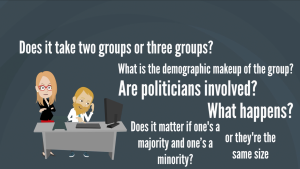 The MRP team members meet again at the Virginia Modeling, Analysis & Simulation Center (VMASC). At this meeting some of the team works closely with Monica Duffy Toft, an International Relations expert and political scientist who helps apply the complexities of social conflict to simulation and modeling.
The MRP team members meet again at the Virginia Modeling, Analysis & Simulation Center (VMASC). At this meeting some of the team works closely with Monica Duffy Toft, an International Relations expert and political scientist who helps apply the complexities of social conflict to simulation and modeling.
Through analysis of the letter written by Mohammed Atta, the mastermind of the September 11, 2001 tracks in the USA, Toft explains the religious justifications Atta used to commit this act of religious violence. According to the Global Terrorism Index, data shows that terrorism-related deaths have significantly increased and have also displaced refugees due to terrorist activity. This data reveals the increasing challenges the world is facing with religious violence, which makes this topic timely and pertinent for the MRP team to study through modeling and simulation.
 The MRP team applies Toft’s expertise in international security and religious extremism to their model on Mutually Escalating Religious Violence (MERV). They hope to better understand religious conflict and what leads to religious violence. Toft expands upon her public policy focus and how she brings research to policy makers to influence their decisions. Through simulation, these scholars aim to build simulations of religious violence in order to better understand it and to experiment with strategic responses to the issue.
The MRP team applies Toft’s expertise in international security and religious extremism to their model on Mutually Escalating Religious Violence (MERV). They hope to better understand religious conflict and what leads to religious violence. Toft expands upon her public policy focus and how she brings research to policy makers to influence their decisions. Through simulation, these scholars aim to build simulations of religious violence in order to better understand it and to experiment with strategic responses to the issue.
 In Virginia, the scholars sit down with three experts to analyze different aspects of religion and effectively include these aspects within the models. The VMASC director explains the multidisciplinary work of modeling and simulation that takes place at the research center.
In Virginia, the scholars sit down with three experts to analyze different aspects of religion and effectively include these aspects within the models. The VMASC director explains the multidisciplinary work of modeling and simulation that takes place at the research center.
 The team travels to San Antonio, Texas for the 2016 American Academy of Religion Conference, which is a worldwide conference centered around all aspects of religion. Here they present a panel titled, “Computer Modeling as a Tool for Religious Studies” to share with other religion scholars why modeling and simulation are important.
The team travels to San Antonio, Texas for the 2016 American Academy of Religion Conference, which is a worldwide conference centered around all aspects of religion. Here they present a panel titled, “Computer Modeling as a Tool for Religious Studies” to share with other religion scholars why modeling and simulation are important.

